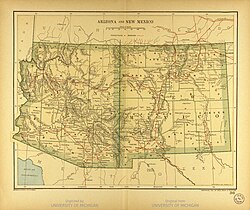
New Mexico’s distinct cultural heritage and intricate history are profoundly shaped by the migration routes that have traversed its deserts, valleys, and plateaus. From pre-Columbian pathways used by Ancestral Puebloans to the bustling Santa Fe Trail and the international corridors tied to the Bracero Program, these routes facilitated not only the movement of goods and people but also the exchange of ideas, traditions, and technologies. By examining these key migratory paths, historians and genealogists can better understand the layers of settlement and cultural fusion that define New Mexico’s identity today.
Research your ancestors on MyHeritage
List of New Mexico historical migration routesList of New Mexico historical migration routes
| Time Period | Ethnic Group | Origination Location | Arrival Location | Motivating Factors |
|---|---|---|---|---|
| Pre-1300 (Pre-Columbian) | Ancestral Puebloans | Four Corners region and surrounding Southwest | Settlements along the Rio Grande Valley (e.g. present-day Santa Fe region) | Seeking arable land for agriculture, access to water sources, and defensible settlement sites |
| 1300–1600 | Athabaskan peoples (Navajo, Apache) | Northwestern Canada/Alaska (long-term migration), moving southward over centuries | Northern and eastern areas of present-day New Mexico | Search for hunting grounds, trade opportunities, and new homelands |
| 1598–1680 (and beyond) | Spanish colonists | Central Mexico (often via Mexico City, Querétaro, and Zacatecas) | Settlements in the Rio Grande Valley (e.g. San Juan de los Caballeros, Santa Fe) | Expansion of Spanish Empire; establishment of missions, forts, and agricultural settlements along El Camino Real de Tierra Adentro |
| 1680–1692 | Spanish returning after Pueblo Revolt | El Paso del Norte area (temporary exile communities) | Reclaimed Spanish settlements in central and northern New Mexico | Reassertion of Spanish governance and religious missions after the Pueblo Revolt of 1680 |
| 1821–1846 (Mexican era) | Mexican settlers | Interior provinces of Mexico (e.g. Chihuahua, Sonora) | Various New Mexican towns such as Santa Fe, Albuquerque, and smaller outposts | Economic opportunities; ranching, farming, and trade after Mexican Independence in 1821 |
| 1821–1880 (Santa Fe Trail era) | Anglo-American traders and settlers | Eastern United States (primarily Missouri) | Santa Fe and surrounding trade hubs in New Mexico | Economic gain via overland commerce (Santa Fe Trail); expansion of U.S. influence in the Southwest |
| 1848–1860s (U.S. Territorial period) | Various Euro-American groups (Anglos, German Americans, etc.) | Eastern and Midwestern United States | New Mexico Territory towns (Santa Fe, Las Vegas, Fort Union) | Western expansion after the U.S. acquisition of the territory; homesteading, military outposts, government roles |
| 1858–1861 (Butterfield Overland Mail) | Stagecoach travelers, mail carriers, and occasional migrants | St. Louis, Missouri / Memphis, Tennessee (routes converged in Texas) | Waypoints across southern New Mexico (e.g. Fort Fillmore, Mesilla) | Establishment of cross-country communication and travel; mail service between East and West coasts |
| 1878–1890 (Railroad expansion) | Railroad workers and settlers of diverse backgrounds (Irish, Chinese, Mexican laborers, Anglo entrepreneurs) | Midwestern and Eastern states; also Mexico | Railway towns along the Atchison, Topeka and Santa Fe Railway (e.g. Raton, Las Vegas, Albuquerque) | Job opportunities in railroad construction; easier transportation for settlers and commerce |
| 1920s–1940s (Early automotive routes) | Domestic migrants (Dust Bowl refugees, job-seekers) | Great Plains states (Oklahoma, Texas) and beyond | Albuquerque, Santa Rosa, and other towns along pre-Route 66 roadways | Economic hardship during the Dust Bowl; search for employment and better living conditions |
| 1926–1960s (U.S. Route 66 era) | Travelers, tourists, and job-seekers | Eastern and Midwestern U.S. (route originated in Chicago) | Albuquerque, Gallup, and other communities along Route 66 | Tourism, transient labor opportunities, and the cultural appeal of the “Mother Road” |
| 1942–1964 (Bracero Program) | Mexican agricultural workers | Rural regions of Mexico (various states) | Farms and railroads in southern and central New Mexico | Wartime and post-war labor shortages in the U.S.; government-sponsored work contracts[1] |
References
- ↑ 1942: Bracero Program. A Latinx Resource Guide: Civil Rights Cases and Events in the United States. Library of Congress

